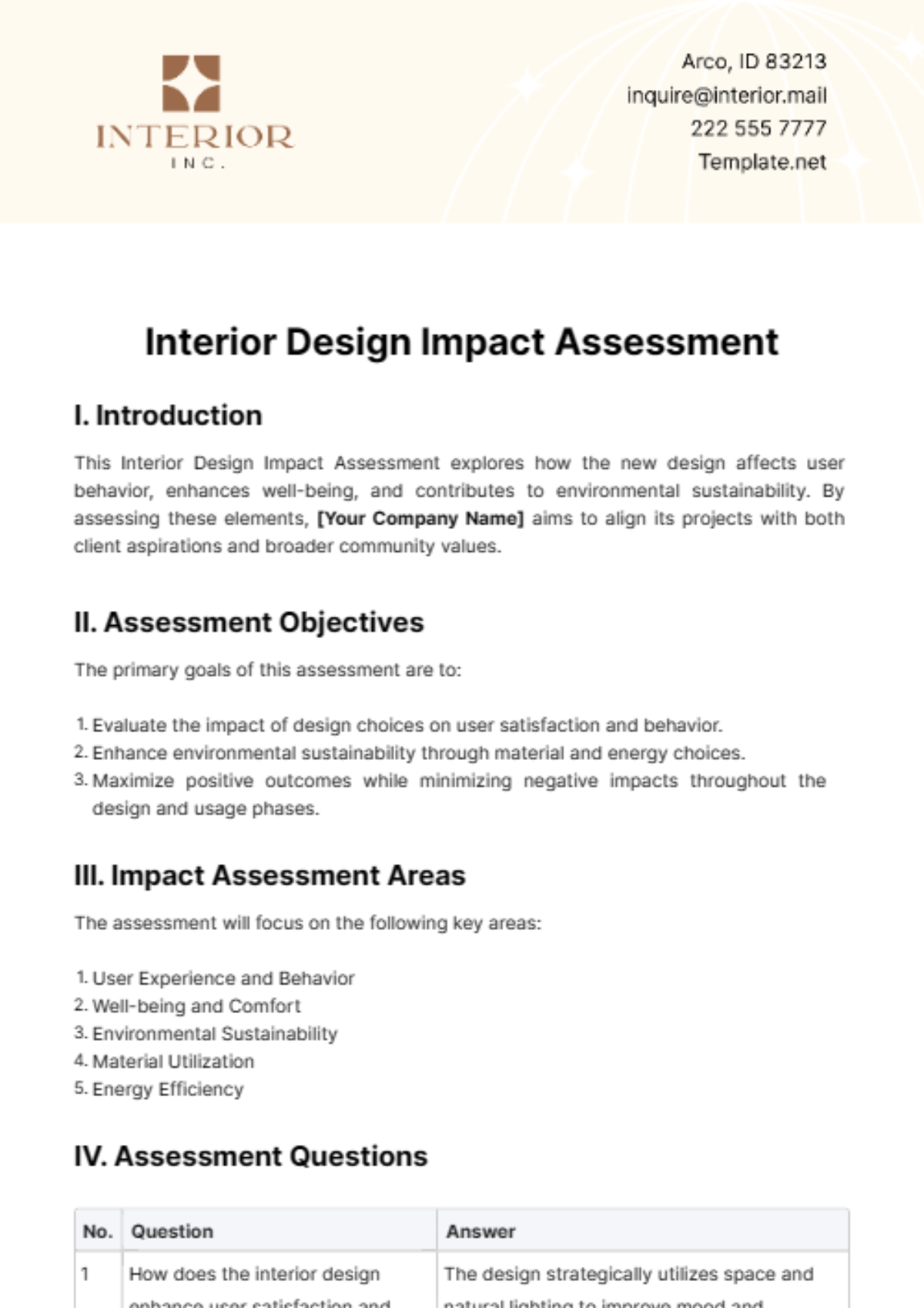Free Interior Design Impact Assessment

I. Introduction
This Interior Design Impact Assessment explores how the new design affects user behavior, enhances well-being, and contributes to environmental sustainability. By assessing these elements, [Your Company Name] aims to align its projects with both client aspirations and broader community values.
II. Assessment Objectives
The primary goals of this assessment are to:
Evaluate the impact of design choices on user satisfaction and behavior.
Enhance environmental sustainability through material and energy choices.
Maximize positive outcomes while minimizing negative impacts throughout the design and usage phases.
III. Impact Assessment Areas
The assessment will focus on the following key areas:
User Experience and Behavior
Well-being and Comfort
Environmental Sustainability
Material Utilization
Energy Efficiency
IV. Assessment Questions
No. | Question | Answer |
|---|---|---|
1 | How does the interior design enhance user satisfaction and behavior? | The design strategically utilizes space and natural lighting to improve mood and productivity. |
2 | Are there any aspects of the design that could potentially harm user well-being? | No harmful elements are present; design focuses on ergonomics and environmental quality. |
3 | What materials are used, and how sustainable are they? | Materials selected are mostly recycled or sustainably sourced, reducing environmental impact. |
4 | Does the design incorporate energy-efficient technologies or techniques? | Yes, includes LED lighting and energy-efficient HVAC systems to reduce energy consumption. |
5 | How does the design contribute to or detract from the environmental goals of [Your Company Name]? | The design aligns with our sustainability goals by minimizing waste and utilizing green materials. |
6 | What are the potential negative impacts of the design, and how can these be mitigated? | Potential for high upfront cost due to sustainable materials; mitigated by long-term energy savings. |
7 | How adaptable is the design to future modifications or improvements? | The design is highly modular, allowing easy updates and modifications as needs evolve. |
8 | How does the overall design align with the core values of [Client Name]? | The design reflects [Client Name]'s values of innovation and sustainability, emphasizing modern yet timeless elements. |
9 | Are there any areas of the design that exceed the expectations in terms of positive impact? | Yes, the inclusion of biophilic design elements has greatly exceeded expectations in enhancing user well-being. |
10 | How can feedback from this assessment be integrated into future projects? | Feedback will be used to refine material choices and design practices, focusing more on user-centric and sustainable design principles. |
V. Conclusion and Recommendations
Based on the findings, recommendations will be made to enhance both the aesthetic and functional aspects of the design while strengthening its environmental and social impact. This process will involve continuing to gather user feedback and monitoring the long-term impacts of the implemented designs.
[Assessor's Name]
[Your Department Name]
[Your Company Name]
Signature:

[Your Name]
This structured assessment ensures that interior design projects not only meet aesthetic and functional requirements but also positively contribute to environmental and social outcomes, aligning with [Your Company Name]'s commitment to sustainability and client satisfaction.
- 100% Customizable, free editor
- Access 1 Million+ Templates, photo’s & graphics
- Download or share as a template
- Click and replace photos, graphics, text, backgrounds
- Resize, crop, AI write & more
- Access advanced editor
Enhance your interior design projects with Template.net's Interior Design Impact Assessment Template. This editable and customizable template is specifically designed to streamline your project's visual and functional analysis. Easily editable in our AI Editor Tool, it's engineered to elevate your presentations and decision-making processes. Unlock the potential of every space and impress clients with precision and innovation. Start transforming visions into realities today!





























